The Eddie Bauer ‘Skyliner’ and how to find one
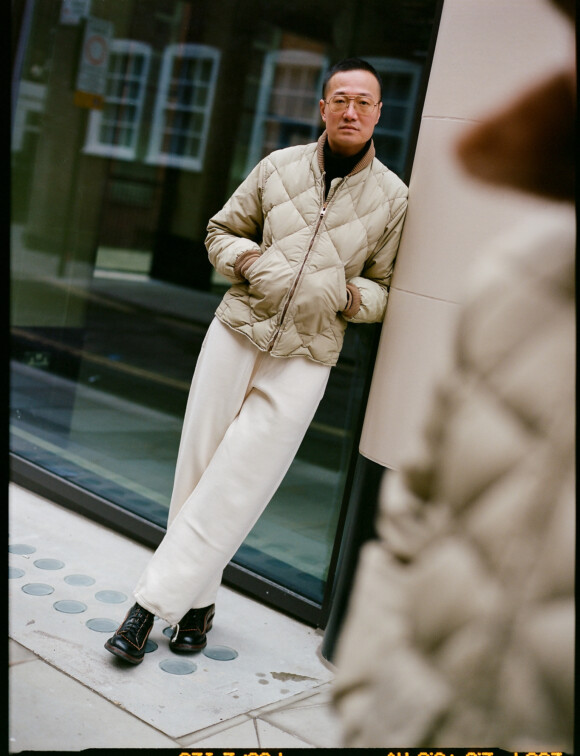
With the growth of interest in outdoor clothing in recent years, there has been a predictable dive into the history of companies that produced it, of which one of the most prominent was Eddie Bauer.
One reason I find this exploration interesting is that a lot of heritage outdoor clothing was more refined than today's puffas and parkas - even elegant. They tended to be slimmer, they had collars rather than hoods, and they used more natural materials - dense cottons for example, or cotton/nylon mixes.
A few companies have done reproductions in recent years, including Buck Mason with Eddie Bauer itself and Bryceland’s, whose down jacket (being reissued later this year) is a reproduction of my favourite style, the bomber-like Skyliner.
But it’s also possible to pick up vintage Bauer cheaply on eBay (especially in the US), which is what I’ve done recently and the guys at Bryceland’s have done in the past. The only stumbling block is that something like the Skyliner was made for so long that the quality slowly deteriorated over the decades - wool ribbing was replaced with polyester, metal zips by plastic.
So I thought it would be useful to get a guide to buying pieces like this from Ben Chamberlain at Bryceland’s, who knows a lot more about it than I do. Here are my questions and his answers, and pictured is Kenji (right) in a vintage Skyliner, as well as Ben (left).
What’s the first thing to be aware of when buying these pieces vintage, Ben?
Most important is understanding what you want: a true ‘archive’ piece, which will come with a high price tag (sometimes staggeringly high) or something which is wearable and affordable, though not as desirable for one reason or another.
How have Eddie Bauer jackets changed over the years?
Since Bauer first started pioneering down jackets in the mid-thirties, they’ve been a constant crossover item from outdoors adventurers to street-style icons. When Bauer first sold his diamond-quilted, down-filled design in 1936 it was revolutionary; the idea was so ahead of its time and so simple that the basic construction has remained pretty much the same ever since - just two layers of fabric quilted and filled with down feathers, for greater warmth retention without the weight.
As not a lot has changed, and Eddie Bauer specifically produced the same designs such as the Skyliner and Yukon for decades, the differences are really in things like the materials and hardware.
When does the Skyliner date from?
The Skyliner is one of Bauer’s recognisable models, and a precursor to modern bomber jackets. Waist-length with knitted collar and cuffs, it was the earliest commercial model Eddie Bauer brought to the market in 1936. It’s easy to see why the design remained unaltered as well as becoming highly collectible.
Kenji’s example shown here dates from the late 1950s/60s. Compared to the original patent the tightly woven cotton outer has been replaced with a cotton/nylon mix - which was found on most down jackets of the time and is still used today - and the ribbing has changed from 100% worsted wool to wool/nylon. The liner also changed over the years as production and textiles changed and modernised.
Are those the key things to look out for when trying to date one, on eBay for example?
Yes, the first thing is the outer shell. You’re unlikely to find a pure cotton one, but the cotton/nylon mixes are great and very functional. The mix changes from 60/40 to 40/60, but they’re all good.
The pure nylon which started to appear in the 60s onwards is a little different, more of a ‘shell’ jacket, which is a little lighter and in-line with more modern streetwear, but still has its place. In the 80s pure nylon shells started to become the standard across all models; these are still fine and have some lovely colours, but lose a bit of the charm of the earlier versions.
Look for the label too. Anyone that loves labels in general would have come across the iconic Eddie Bauer ‘Sun’ logo. Used from the very first jacket, it is instantly eye-catching: the rich gold of the sun rising above the horizon, the cold blue of the ice flow and red ‘Bauer’ lettering all set on a black background. The perspective of the ‘Bauer Down’ text is set central, like a monolith, or the opening credits of Star Wars – it’s epic.
This label was used from the 30s right up until the 1960s, with a few minor changes over that pretty vast time-period: the placement of the ® symbol and the ‘Blizzard Proof’ text date the jacket to the 1960s, while dating before then can trickier.
Jackets with these labels can be pricey, so the best place to start is jackets with the gold script logo - and the fetching, but quite plain ‘cubist’ mountains - that replaced the sundown logo in the late 1960s. Another plus for later jackets is the vastly expanded colour palette, which can be a bit more fun and in-line with modern repro-brands like Rocky Mountain featherbed.
Other changes include the lining, but this was nylon from the early 1950s onwards, and the zips, which were plastic in later years. Metal zips, and specifically Talon zips, are a good indicator of earlier jackets, and specifically those produced earlier that the 1980s.
Did the design of the Skyliner change in any other way?
No, it was noticeably timeless. It’s short in the body but not too much, which proportionally makes it easy to wear and pairs effortlessly with most casual items. The only limitation is that the shape reduces the amount of layering you can do.
How does the performance compare to a modern down jacket?
It depends what you need them for. If it’s just to keep warm, then vintage is still good, tends to be cheaper, and as mentioned has a touch more character. Modern down jackets will have sealed seams and be more water resistant, but down jackets aren’t really designed for rainy weather.
If you wanted to go hiking or climbing, modern would also be a safer bet, although on a trip to Iceland last November I took a vintage 1960s nylon shell Eddie Bauer and it served me very well, great for layering.
Compared to modern repro down jackets, if you can find a vintage one you like then vintage makes more sense monetarily and in terms of sustainability; but there'll be a certain amount of compromise regarding options and colours.
What other models from Eddie Bauer fit this vintage, streamlined aesthetic?
The best known model apart from the Skyliner is probably the Yukon, which Bauer released in 1946. Closer to an overcoat or parka, it’s smarter and a little more stylised - cut long with a full mouton collar and more tailored fit. The design is a little dated today, but it’s a great piece. The man himself described it as “the aristocrat of all down jackets”.
What other brands from the period are worth watching out for?
Though Eddie Bauer is the best known, there are brands which sometimes get 'left out in the cold' when looking at down jackets. Seattle Quilt MFG had been making quilted-down sleeping bags since the 1920s, a good 15 years before Bauer took that idea and put sleeves on it. When they finally saw the potential for their product, they started the Comfy sub-brand in 1936.
The jacket I’m wearing here is one of the earliest Comfy designs - from the late 40s or early 50s - and is similar to the Bauer Yukon. There are some elements of the Comfy that I personally prefer though: the diamond quilting similar to the Skyliner, the scalloped pocket design, the slightly larger collar and the burgundy sateen half-lining.
In the late 60s into 70s the Comfy brand had a distinctive style shift, producing slightly more western-inspired jackets. Nylon shells, shoulder yolks, brighter colours; these are a lot of fun, cheap and easy to find. The logos a bit of fun too, very much of the time.
Beyond Eddie Bauer and Comfy, there are other smaller brands from the 50s and 60s: Alaska Sleeping Bag Co, Alaska Feather Down, others that don’t have Alaska in the name. Then in the late 60s into the 70s there was a boom in companies specialising in down-jackets and outdoor attire: Sierra Design, Rocky Mountain Featherbed, Powder Horn, North Face and of course, Patagonia.
Many of these companies’ designs were very similar if not identical, essentially white-labelled. But there are some good examples and nice colourways out there, making them a great way to find an inexpensive and wearable down jacket at a fraction of the cost of a new one.
If eBay is the best source for the cheaper end of the market, particularly in the US, one of the best for the very high end is Saunders Militaria. Increasingly many vintage shops stock outerwear along these lines though - some of the best I found were in Korea at places like Omnipeople.


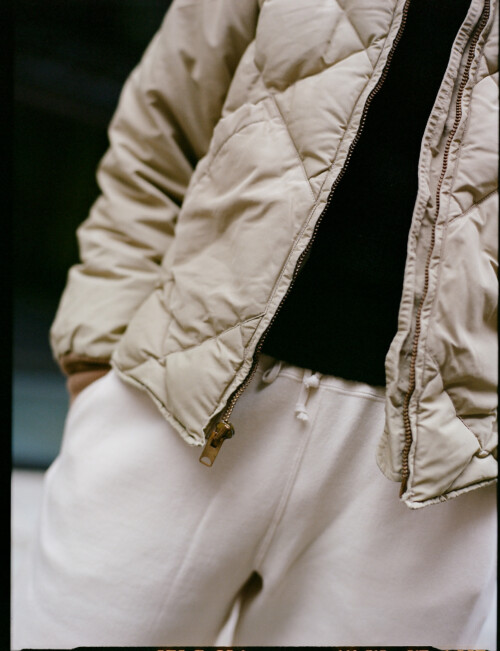
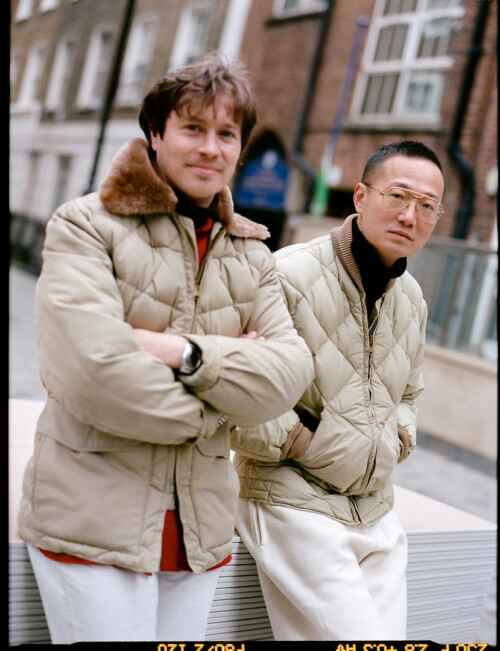
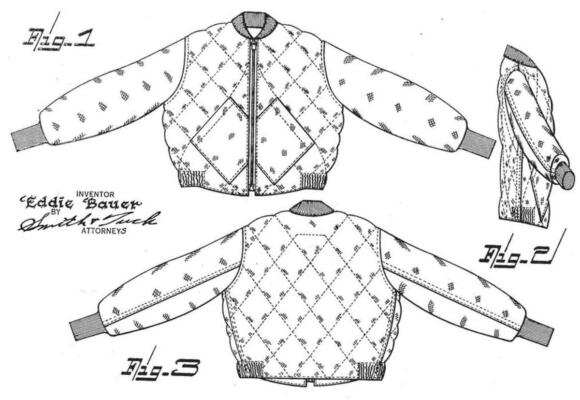
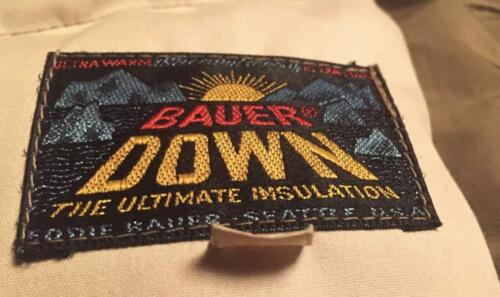
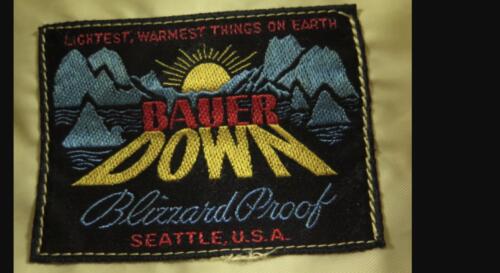
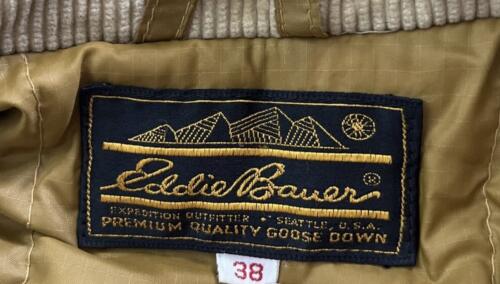
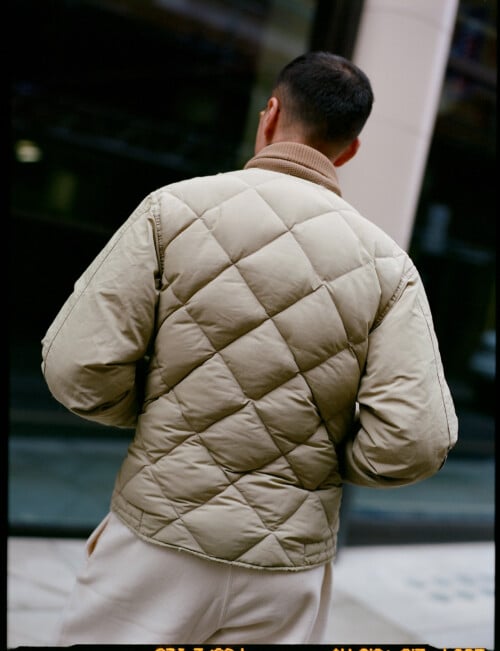
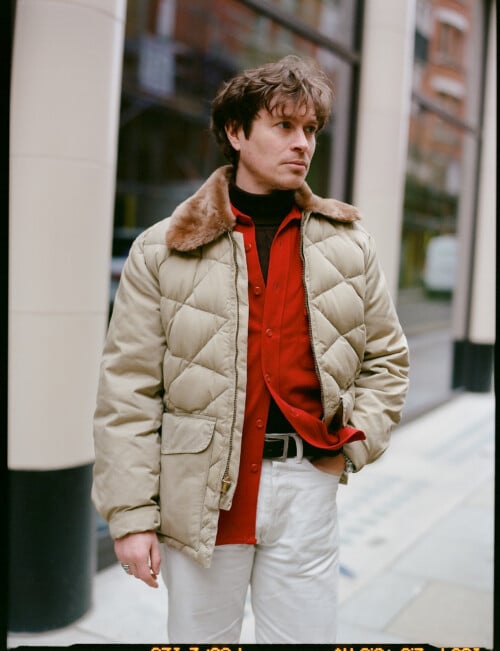
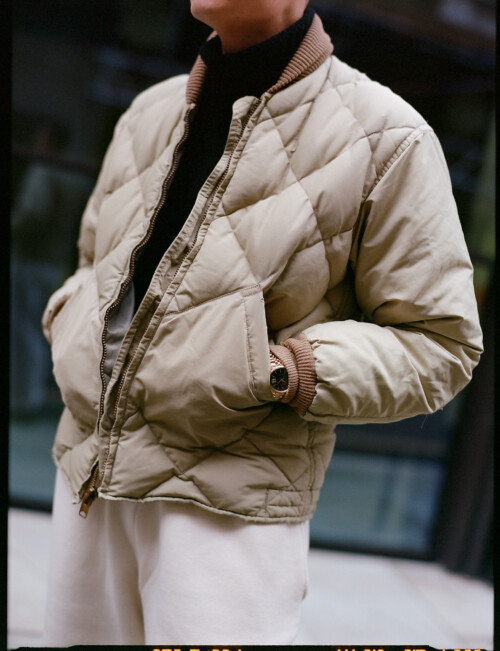


























With vintage like this, if a product meets the description above (eg Star Wars style label) do you have to worry about counterfeit – or is it not worthwhile / impossible to create aged products?
It’s not really big or popular enough to attract counterfeits Alex, no.
Very nice pieces.
I don’t generally buy vintage outerwear or vintage clothing generally but my default outerwear is my trusty Berghaus fleece, albeit in an entirely different league altogether.
That said..if I were to upgrade to something better allowing for my 50”+ chest, can you recommend any makers ?
I probably couldn’t give an specific advice based on size Lindsay, but other readers might be able to.
Do you mean a better fleece, or a down jacket like the Skyliner?
I would say both actually.
I am open to advice on all options.
Moorer (Verona) is specialized on satorial down jackets / coats / parkas (I own a down coat, which is not puffy at all — the exterior is made of wool)
Interestingly, also Suit Supply has very good ones (I own a navy Parka, puffy but warm, with a wool exterior).
I recommend that you try to avoid a polyester/nylon exterior but go with wool or cotton, which imo looks much better.
Hi Marcus.
Many thanks for your kind response.
Had a look at Moorer.
Beautiful products but expensive.
I’d also say, a rather different look, quite Italian luxe
Lindsay, a lot will depend on how functional you need a fleece or down jacket to be in seriously cold places or if it just needs to be a warm jacket for a more casual wear. There’s a move away from fleece from purely synthetic fibre because of the micro plastics they shed. Wool fleece or at least a mix is becoming more popular. Have a look at the Scandi brands – Klattermusen have some more interesting designs as well as being very solidly made. Fjallraven and Norrona are two others, not cheap but then again not ridiculous prices as some stores featured occasionally on this site have.
Super info.
Many thanks Kev for your kind response here!
Hi Lindsay, if you can look past the logos Ralph Lauren Big and Tall will at least have things in your size,
https://www.ralphlauren.co.uk/en/pile-fleece-jacket-656921.html
pauw.com from the looks of it also has quite a few size 50, a quick look got me Kired and Montedoro
https://pauw.com/en/men/penna-reversible-bomberjacket-kired-644m6000219e528.html#200=916
https://pauw.com/en/men/casual-jacket-montedoro-64255400029n380.html#200=916
Many thanks David
Lindsay
Maybe try Daniel Simmons. They have some solid wool blend fleeces with a generous fit.
Hi Simon, what sweatpants is Kenji wearing in these photos? Thanks
A prototype of a new model from Bryceland’s – very nice
Also, working in intellectual property, I didn’t expect to see the drawings from a design patent in a post here, and looking it up, while the Skyliner was originally made in 1936, the patent (US-D119122-S) from which the drawings are taken was filed 26 December 1939 and published 20 February 1940.
Thanks Aodhan, I’ve updated that
I picked up the latest iteration of the Skyliner in the Pumice color just before Christmas directly from Eddie Bauer for $125 (on sale and I used a couple of discount codes). It’s still on sale for $189.99 with an additionally 40% off with a code, so about $114.00. Stylewise, it’s almost identical to the classic Skyliner with a 650 down insulation, although the materials are obviously more current (73% nylon, 27% cotton shell with a DWR coating and I believe the cuffs are a cotton/synthetic blend). But it has the classic diamond quilting, a matte finish on the shell and the iconic “Sundown” tag at the neck. There are other colors available and some other collab versions are out there (the one with Huckberry with a blanket lining and another with Buck Mason in an Olive shade). It’s obviously not vintage. But it definitely delivers the right look.
One other thing I’ll add: I’ve collected a fair amount of vintage outerwear over the years and I’d urge caution when buying older down pieces online. While the piece may look pristine in the photos, down deteriorates over time, drying out as it loses oils or from improper washing or just from wear and tear. It’s worth remembering that most vintage down workwear jackets and vests were probably originally purchased for practical reasons, not fashion, and likely saw some abuse over the years. As a result, many of them have likely lost a fair amount of loft and their insulating properties. So double check the seller’s return policy when buying vintage. Cheers and have a great week!
Hi John,
That’s great, thank you. I hadn’t seen any of the current ones so great to have the comparison. There’s also a collaboration Bauer are currently running with 2nd Magazine, but I think that’s just for the Karakoram.
I haven’t had any issues with the down in my vintage pieces, but hadn’t thought about that as something to watch out for, so thank you. Returns being another reason it’s easier for readers in the US.
What about Buck Mason collab instead of vintage? Did you hear about it?
Hey Adrian – yes I mentioned it in the piece and linked to it?
I wouldn’t say it’s exactly the same as the vintage pieces, no, and something like the Bryceland’s is a higher level, but Lucas has one from Buck Mason that I’ve seen and it seems very good for the price
I bought the Huckberry collab earlier this month and like it. Coated nylon/cotton outer, a nice wool mix lining, and a metal YKK zip. For the $164 sale price I paid, I think it is pretty good. A few left in large in the green and lots in a smoke colour that I don’t think really works.
Thanks Clive. Are they warm? I like the lining but it doesn’t look like there’s much down in that quilting.
They also don’t have the fold-up collar, but that’s a personal thing. I think that adds some nice style, either making a thicker collar or folding up for rollneck-like warmth
Very nice article about something that most people wear but never look good in it. Could you Simon or anyone from the ps readers suggest other stylish down jackets ? Id like something for everyday use that fits with jeans mostly.
This is the only one I have – others I’ve tried were always that bit more bulky. The Rocky Mountain Featherbed ones are nice but I preferred a natural outer material rather than just synthetic.
I’ve also tried the Yukon but found the style didn’t work as well. Prefer Ben’s one here though ideally with a smaller collar.
Hi Georgios. Apologies in advance if you already know this, but the thing with down (as compared to some synthetic insulations) is that the warmth comes mainly from the loft. More loft generally equals more warmth, which means a warmer down jacket is going to be inherently “puffier”. This is also why you see measurements like 650 fill or 800 fill and the ratio of down : feathers (80:20, 90:10) on more technical down jackets (higher fill power and more down vs feathers = a puffier but warmer jacket). So maybe a place to start would be to consider your priorities (warmth vs. a more tailored fit). There are plenty of blazer style down jackets out there from brands like Moorer, Herno, Moncler and even Brooks Brothers. I would just note that the shell fabric on these blazer styles is often heavier (sometimes a wool blend, tweed-style material or a twill) rather than the lighter weight ripstop nylon you’d see on a technical jacket. This heavier fabric will compress the down insulation and that, combined with the normal use of a lower volume down and the trimmer fit means it will likely be less warm. But they’d would still look good with jeans imho; a little dressier but still kind of rugged. Hope that helps a little!
Asthetically, I have always liked the Real McCoys version, whether it’s their deerskin vests or – if you want a “proper” piece of outerwear – their “COTTON/NYLON HOODED DOWN JACKET”, although I must admit, I have never seen either in person.
I know that you own the RMC deerskin vest in person Simon, but wonder about your opinion on the latter. Have you ever seen it in person?
I haven’t, sorry Felix.
Hi Georgios, perhaps have a look at Crescent Down Works if you haven’t already. They’re a smaller brand, and they still make their goods in Seattle.
Thanks Andrew. We’ll be featuring them soon actually
Oh good, that will be fun to see! Thanks for the heads up.
Agree. No matter how hard I try, and how well they outperform wool in dry conditions, I still cannot bear to wear down jackets for anything but actual hiking, they just look too funny and unstylish to me.
Yet this diamond quilting somehow does the impossible. It’s not as nice as wool, of course, but I could see myself wearing one of those unlike typical down jackets. If only I could ever find one, it doesn’t seem there’s any real availability in Europe for a reasonable price (meaning a price not overly inflated by great scarcity) so I’ll probably have to sit out of this one.
Given how cheap some of them are, it’s worth paying a little bit extra for the shipping and a bit of duties often in Europe.
Also I would just say these old down jackets are very different style to modern ones, it’s not that weird they don’t share that much in common in terms of fit usually for example
At the risk of being labeled as “difficult” there is absolutely nothing stylish about track pants. Even if they have a label or whatever.
One can see them in Walmart all the time.
I don’t think you’re going to be labelled as difficult, just off topic and probably a little dismissive. It’s a conversation for another day
How is it off topic? There is a photo of someone wearing them on your website?
Dismissive, perhaps, but I’m sure you’ve dismissed things in the past. We have to chose the things we don’t like, as well as like.
Yes, but it’s not the topic under discussion, and it’s one we’d need to talk about a fair bit for it to be in any way useful, which is the point of the article and subsequent comments.
Great article Simon, Ben is great and always a please when visiting Bryceland’s. Based on this article i directly checked various website in search for a vintage version.
Unfortunately, it seems like the “sun” logo is used in their recent version aswell and therefor no longer an indicator of Era and therefor quality.
True – it is easier to tell apart those current ones from the very old ones though, more than between a decade here and there anyway. The materials will always be different
And so a new personal obsession commences – scouring the internet for an Eddie Bauer jacket…and wishing a Buck Mason / Eddie Bauer collaboration was available in my size!
Love the background info on the labels, those guides are always great while thrifting or eBay hunting.
While a lot of these vintage pieces can fetch high prices for those who know what they are, there is an absolute bounty of vintage Eddie Bauer, LL Bean, etc floating around the northern US. I found a vintage Eddie Bauer Kara Koram parka (with the gold cubist mountain logo) in absolutely pristine condition on eBay for like $80 this past fall. I just spent a few months waiting and perusing eBay before I found it.
While more and more good vintage stuff like this gets snapped up by resellers, there’s just so much of it sitting around in closets. If you’re willing to wait and keep your eyes peeled, there are some great deals to be had.
I still wear an Eddie Bauer made in USA down vest that I bought new in 1974. The vest has a nylon taffeta shell and a rip stop nylon interior. It is well made but not significantly better than my newer Bauer down vest. I also own a couple of made in USA down jackets from the 1980’s that are still going strong. I would caution against buying vintage rain jackets. Seams were not taped or sealed well and Goretex laminates deteriorate. I no longer wear the Kelty or Jansport rain jackets I purchased in the 1970’s as newer models are far superior.
Nice to hear some lived experience! Thanks
My grandfather had one of these from the 1960s – I wonder if it’s in the back of a closet at my parents’ house (& if I can find it before my thriftin’ nephew does)
Simon interested in your take on the length of these jackets. Seems like they hit right where you normally would recommend we avoid short jackets hitting (e.g. right in the middle of the seat).
Also, if I may, these seem like a good match for jeans and more workwear Chinos, maybe also vintage militaria pants. Am I missing any other good matches in your eyes, for pants?
Hey Calvin,
It’s interesting, it depends a little on the model and on whether the elastic is still working fully. If it is, then the elastic cinches in above the seat and gathers it there on the waist, like a bomber jacket. That was more the original style, as you can see in the patent illustration. But over time some lose the elasticity and drop a little lower, like Kenji’s – though even his would sit higher if zipped up. Modern ones all sit higher and cinched.
You’re right on the main things to wear it with, but it is also nice with charcoal flannels and a lambswool sweater, for me, perhaps with boots. A smart/casual look. Also with tailored cottons, with cords. It works better in that combination, for me, that the bulkier modern puffas and parkas
Ah interesting to hear on the vintage vs new conditions regarding the bomber! I’m still eyeing the new version that another commenter mentioned that is on sale, but the wardrobe is so full aready! ha
Thanks for your feedback on the pants, it would be an interesting combination with flannels, very high low. I’d love to see that one day. If Kenji can pull off wearing it with sweats and dark boots I’m sure he could pull that off as well!
Thanks for the informed responses, as always. Cheers
A bit down the down rabbit hole, but I recently came across this spreadsheet detailing the warmth to weight ratios of readily available down jackets designed cold weather outdoor adventure. I wonder where the Skyliner would sit in the lineup.
If I had to guess, I’d say probably one of the poorest performers on there, if you’re looking to maximize warmth and minimize weight. Modern high-performance jackets are just far, far superior in those categories compared to any vintage, reproduction, or fashion-forward down jackets. If you’re talking aesthetic appeal, I’d say the Skyliner beats every one of those! By the way, thanks for sharing that spreadsheet, what a great resource.
Yes exactly – it’s the difference between a leisure garment and performance one. You don’t need the latter the vast majority of the time, but if you are going to climb a mountain, your priorities will be different
Yes, there is a risk of looking foolish when donning rugged outerwear, big puffy coats, clunky boots, etc., when your only adventure for the day is a trip to the coffee shop, browsing a book store and so on.
I think the clothes we wear should not be worn in such a way that strays too far from their original stated function. I have exceptions, like we all do: I have some great vintage hunting coats, though I’ve never gone hunting in them. I don’t have any moral opposition to hunting, I just haven’t gone. My stylish boots, however, I justify owning by going out for long hikes.
Michael, I think you’re right. This article makes it sound like the Skyliner was a groundbreaking high-performance jacket in its time. In 90 years, I doubt those interested in menswear will look back on high-performance jackets from 2024 as favorably as we look back on the Skyliner today. But goodness, when I’m out in the backcountry I’ll take my Feathered Friends Helios ten times out of ten. And even in the city, aesthetic appeal goes out the window when the temperature drops to -34°C. Very glad you enjoyed the spreadsheet!
Hmmm. I wouldn’t agree that modern ‘performance’ clothing is superior. I’d prefer to have wool or worsted wool ribbing and dense cotton shells and lining than polyester or nylon. A major issue when wearing clothes for outdoor pursuits and winter sports is breathability when moving and staying warm when you stop moving. Natural materials i.e. cottons/wool/down outperform synthetics. It’s possibly the case now that so few people have been able to wear and experience the former that they are blissfully unaware of what they are missing out on. I’ve moved away from synthetics and replaced almost all my outdoor/sports clothing and find it a much better experience in all weathers.
Aside from maintaining an optimal temperature with natural materials, I found wearing a down puffer with a nylon outer drove me crazy due to the rustling sound it made as I moved. A jacket I have with a mouton collar similar to the above is great for keeping my neck and also my core body (as it’s tight fitting around the neck) warm and I don’t have that rustling sound every time I turn my head. Minimising weight is over-rated and a marketing gimmick in my opinion.
Con, I appreciate that you put such emphasis on the importance of moisture management during outdoor winter activities. Do you have a system where you move and sweat in a set of lighter layers, and add insulation when you stop? Or do have a setup such that you prefer to keep all layers on at all times? I’d also like to hear more about your thoughts on weight minimization being a marketing gimmick. Do you think there are any circumstances where a modern high-performance down jacket (from the likes of Feather Friends, Cumulus etc) would be more useful than a comparably warm cotton/wool/down setup?
Generally I like to not have to remove any layers, but if I do, I prefer to remove my outer layer/jacket only e.g. if the sun is out and it’s just not that cold/no wind. I do layer with lighter layers to begin with. Depending on how cold it is, I may begin with either a 100% merino or 50:50 Merino/Poly thermals for skiing/hiking in snow. Depending on the temperature and the length of time I’ll be out will determine whether I choose 100% merino. For not so cold and shorter periods out I don’t mind wearing 50:50 blend thermals or none at all.
Two pairs of wool socks or ski socks one worn over the other to prevent blisters and feet getting cold when stopped for a while. In the UK I can often just wear decent fairly thick fully cotton tube sports socks – none of the big sports brands make decent sports socks anymore. I actually found some decent ones in John Lewis and bought a ton of them. I have a variety of gloves varying from wool to cashmere onto goose-down mittens for extreme cold conditions. I also have very thin inner gloves made from merino as a back up, and Merino neck gaiters and balaclavas from Aldi. A variety of merino and worsted wool fisherman type hats I’ve picked up over time.
Then a mixture of tops. A thin wool vest with no collar and also thick one with fold-downable high ribbed collar that goes around the neck and up slightly over my ears/back of my head – very similar to the collar on the Skyliner jacket pictured above in the article. A bunch of cheap thin merino mock necks and turtle necks from Uniqlo and some heavier wool jumpers and amazing thick cardigan from NorthSea Clothing – so well made. Some cotton sweat tops/qtr zips/turtlenecks etc. A few different outer jackets i.e a cotton barn coat from Lands End, a down puffer, a densely woven cotton smock for wind protection all depending on the activity.
I’ve worn a very well made Napapijri 800 power goose down jacket in the past but while it was fantastically warm, the outer shell rustled and drove me crazy while also having no breathability or ability to regulate temperature. This is major issue with poly and nylon shells. I have 60/40 cotton/poly replacement which is alot better but would still like to replace with something that has no or only a tiny amount of polyester. The only circumstances I can think of where the Napapijri or similar modern performance jacket might be ok or even better would be on a snowmobile. With ear muffs, there’d be no concern for the rustling sound and there’d also be no concern for trapped moisture as you wouldn’t generate much if any sweat at all.
Sweat/trapped moisture when stopped for a period is uncomfortable when wearing synthetics. This can turn to being dangerous if you become cold and begin to fatigue with both compounding each other. Coldness makes you weaker. Better to have clothes that prevent this and to be physically prepared i.e. be optimally fit for the activity than to seek out ways to minimise weight in my opinion. I’m still working on trialing and adding new bits. There are some great thick wool cardigans and also smocks from some of the Scandinavian countries I’d like to try, many of them vintage. A lot of what I wear isn’t ‘sportswear’ per se but it works for me.
Con, thank you for your thoughtful response. I enjoyed reading about your experience with cold weather dressing. Bundling up against a bitter day can be such a delight. Stay warm out there!
The Cumulus Neolite Endurance sits at the top of those ranked for its optimal light weight/ warmth combo.
So, I looked it up, and like so many modern down coats, it has that paper thin, plastic looking outer fabric which looks as if it would tear apart upon simply rubbing up against a tree. It just looks so frail, I’m not sure it would “endure” the produce section at the grocery store.
Typically the point of these types of ultralight jackets is to be worn under a more abrasion-resistant shell. They pack down to nothing and weigh very little, so they’re easy insurance for when temps plummet on a long hike. Plus, the thin fabric is typically pretty amenable to patching in the field if necessary.
Leif, the shell of that Cumulus Neolite is certainly very thin! However, it’s durability might surprise you. I’ve a FF Helios with a 20D shell (compared with the Neolite’s 10D) that only has one small rip after 8 seasons of use. Not that I would recommend wearing either in the produce section!
Ha, ha!
Thanks for the interesting info. Of course, I could counter that I have a nice pea coat that I’ve owned for nearly 20 years which would only tear if you took a chainsaw to it… and looks far less preposterous than a big “puffer” when simply walking about on a cold day in the city or country, and does not have the pretense to call itself an “expedition” coat.
Is this a sartorial fisticuffs I’ve started? 🙂
Take care.
Leif, it sounds like we both agree that a good wool coat is much preferred to modern plastic technical outerwear for wearing around during the course of everyday life! Sorry to disappoint, but I don’t think fisticuffs are in order. But for ice climbing expeditions? Get me that big “puffer!”
This is right up my alley. Many years back, this sort of stuff was going dirt cheap on ebay.
It was then that I snatched up several EB jackets, similar to the pointed corduroy collar model in one of the ads you post but the pockets are more covert and not such an angled, patch style.
Most that I have are beige, one is a dark slate blue, and all being true goose down, they are amazingly warm for such a short, light-weight, easy wearing jacket style.
(as a reference, there’s a version selling now on ebay from an Illinois seller for $115 “Vintage Eddie Bauer Olive Green Puffer… “)
By the way, as enamored as I am of these old EB jackets, I do not… DO NOT… like the one with the faux fur collar which screams “worst of the ’60s and ’70s” 🙂 The other models, though, are beautifully timeless.
As others have mentioned, it’s great to see those different label designs. I have an Eddie Bauer and Nigel Cabourn collaboration version of the Everest Parka and the label stating “Lightest, Warmest Thing On Earth” always makes me smile. I suspect the claim wouldn’t stand up to much scientific scrutiny but I do like the boldness of it.
I guess it did at the time, which brings up an interesting question – which age of technology do we really need for day-to-day life? 60s? 90s?
Wool and linen did the trick for centuries for most of the Western world; sheepskin and furs in the colder areas.
Why is it that clothing co’s that make good products then go onto to reduce the quality of these over time? I know some other industries do the same but I would have thought that it’s a sure way to kill a brand or lose loyal customers or at least diminish a once great reputation.
When you look at electronics/tech for example. In the last few decades they have continued to innovate and it’s staggering the value for money you can get for incredibly high quality made products now. I believe Sony may have led the way somewhat with their Kaizen principle so maybe other co’s were forced to chase them.
With clothing, brilliant products are now often a shadow of their former selves and if the same had happened with clothing as had with the electronics industry, we’d have so many wonderfully made clothes. Instead, duck and goose down gets replaced with polyester. Same with high quality cotton and wool clothes. Design features get removed. I have a very well designed merino cycle top which has a ‘movement’ panel on the side all the way up underarm and along to the wrist. It’s also got a different weave to main body of the top which allows alot of movement. The latest iteration I picked up has had this panel removed, so now the top rides up when my arms are extended. I’m expecting the merino to to switched to include a percentage of polyester next season.
Fit also. You mention the heritage brands were slimmer. I have great difficulty finding clothes that are not billowy. It’s often not possible to slim down outerwear. I presume this is due to expanding waistlines. This is another reason I’d like to see more casual wear being offered MTM if not bespoke. It becomes an ever increasingly frustrating mission to find well made clothes. I can’t be alone feeling this way. Or am I? Is the demand just not there?
It’s the customer demand, Con. Today people are willing to pay effectively £1000 for a phone, but they are not prepared to pay good money for clothing.
Why that is is a long and complex debate, but a lot of those companies go downmarket to survive rather than to increase profits (though the latter happens too).
It’s why it’s so important to communicate to people the point of quality clothes. And that most of the clothes they wear are garbage
I see. I guess the lack of education on clothing that people have in general must play a big role in buying decisions.
Well, I’m glad that you do what you do. It was my search for better fitting and quality clothes that brought me here and it’s been an enormous help in understanding and appreciating the value of good clothes and materials.
Oh good, that’s lovely to hear Con. Spread the word, in any small way you can
Not accustomed to such unvarnished honesty. Definitely got a laugh out of that last sentence over my morning coffee.
Thanks. You get a fair bit of it on PS. It also references articles in the US recently about how poor quality modern knitwear is
Another thing that can occur is that a high quality “well kept secret” of a brand, with a loyal fan base, may suddenly catch on. This requires the brand to produce at a much higher rate. The brand in turn is almost forced against their will to cut corners, thus creating a lower quality product. This happened with Chippewa boots. In fact it happened with many brands when the internet showed up, causing great old work brands that were mainly only known by people that did serious outdoor work, to be discovered by anyone who could type “work clothing” into google. So, Carhartt, Filson, Chippewa, etc.
I’m not sure that’s necessarily accurate, Leif. Just because a brand becomes popular, it doesn’t mean they have to produce any more, and certainly don’t have to cut corners with production.
Eg Alden are very very popular now, but mostly they’ve just limited who they sell to, increased lead times, and put up prices. Also Hermes with its leather goods – all still made in France, and production has grown but only steadily, the haven’t outsourced. Hence the waiting lists
Different stories for different brands apparently.
Your examples dealt with increasing demand wisely, while others have not.
No, it’s not an inevitability that an increasingly popular brand will cut corners, as you point out, but it’s a temptation, or a misstep that’s too easy to make and certainly has occurred in some cases. Chippewa is an unfortunate example.
By contrast, Red Wing went from a ho-hum brand decades back to a much improved brand and met the high demand for stylish work-wear with their Iron Ranger model… though, I suppose they’re not quite at the level of Vibergs (another boot brand story altogether).
By the way, stitchdown dot com is a great site for all things boots related.
https://www.stitchdown.com/
Thanks Leif, yes you’re right on both. And yes, I know the Stitchdown guys, they helped with my piece on work boots
Back in the 90s here in NY, during the heyday of Polo Sport and Tommy Hilfiger, brands like EB and Land’s End were considered the blandest, most middle-America-uncool clothes around. Fast-Forward 30 years: Now that many a white-collar worker here in North Brooklyn has appropriated some version of the blue-collar man’s clothing as a fashion statement (this area is without a doubt home to the highest concentration of young men and women in pristine painter/carpenter/mechanic/railrod-lineman-circa-1930 outfits anywhere in the world. Funny that these are exactly the kind of jobs they came to NY to avoid in the first place…) jackets like these are cool enough to be featured here.
Are they still bland, just in demand? The general trend towards blandness, colorlessness and shapelessness, especially in men’s clothing, appears to have accelerated over the years. Or is there something great about the design of these clothes? I ask in all sincerity.
No Willy, the biggest difference is we’re talking about earlier versions of those EB clothes, which had more style and more quality. By the time you got to the 90s a lot of that had gone.
What does the term “white labelled” mean?
It means a factory/brand makes for another, for them to put their name on. So kind of with a white label, ready for the brand to put their name on
Hi Simon,
Great article. Do you have any knowledge of the Eddie Bauer Snap-Jac? Differences between that and the Skyliner?
Many thanks in advance.
Yash
I don’t, sorry Yash, but I can ask Ben if you’re interested.
Hi Simon,
Yes please do ask and let me know. Would be useful as I currently perusing a couple of options.
Many thanks in advance.
Yash
No worries, will do
Hi Simon,
Hope all well?
Did you manage to get any feedback on this from Ben? Apologies – not pushing – just want to see if I can make an informed purchase between the choices I have.
Many thanks.
Yash
Sorry Yash, no he had no extra information
Hey Simon,
No worries and thanks for trying.
The esoteric nature of the nerdier details of vintage are a part of the fascination I think.
Yash
Very true. It is about the pure love of clothing itself
Yes absolutely! A love of the details leads to a deeper love of the clothing itself. And it has definitely made me more discerning (or fussy).
For example it puts me off when the design and materials are good but costs have been obviously cut with buttons or zips for example. I might still buy the item but will replace the buttons with horn etc.
Not sure if that’s going too far with things but I love the whole process really.
No that sounds great Yash. Particularly when you can elevate something yourself like that, with just a small change
Thanks Simon,
The knowledge and crucially the impetus to elevate gained in large part on these pages.
Yash
Hi Simon
Any idea where the red shirt Ben is wearing is from?
thanks!
I’d imagine it’s vintage, but I can ask. Looks similar to my Scouts one here.
Hey Bill,
It is vintage – a 1930s/40s Town Craft, similar to a CPO hunting shirt design
Thank you Simon! Appreciate that.